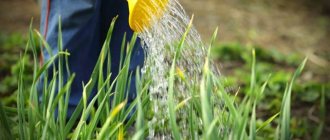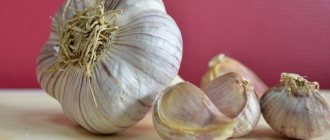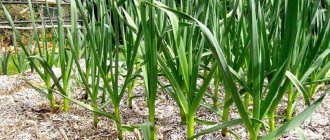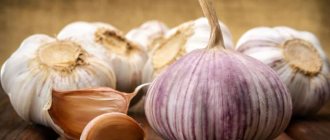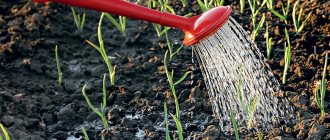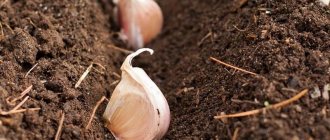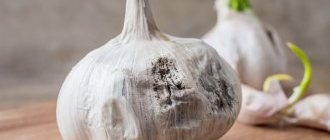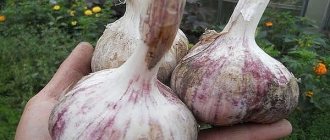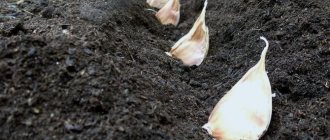How to prepare garlic for planting in the fall
Garlic is a popular food plant. According to its biological characteristics, it is a herbaceous perennial, a species representative of the Onion genus, and belongs to the huge Amaryllis family (Onion subfamily).
This is interesting. Florist and researcher of Central Asia Vvedensky A.I. claims that the forefather of garlic is the long-pointed onion. The first varieties of the culture were discovered in the mountains of Turkmenistan, Tajikistan and the Tien Shan mountains. In Egypt, Ancient Greece and Rome, the spice began to be cultivated in the 6th century. BC e.
How to treat garlic before planting before winter? In general, growing garlic does not require Herculean efforts and material costs. But culture has characteristics and preferences.
Differences between spring garlic and winter garlic
Both garlic can be planted in both autumn and spring. However, they are different.
Winter garlic has fewer cloves, but they are larger in size than spring garlic. It shoots, but stores well until spring.
Spring garlic has more cloves, but they are smaller in size. It does not shoot, is suitable for pickling and processing, but it is not stored in winter.
First – preparation and selection of seeds
Rules for preparing garlic seeds (cloves) for planting in the fall:
- The largest cloves in the head are selected for seeds, according to the varietal variety (a large clove yields a harvest of a large onion);
- small slices are planted, as a rule, for seeds;
- disassemble the bulb into slices no later than 2 days before planting;
- carefully remove the scales from each slice with a knife (thrips “live” behind the protective scales); some gardeners do not remove the covering scales;
- to facilitate the procedure, the heads are pre-soaked in water for 1-2 hours;
- Initially, the teeth should be smooth, clean, without damage, dents, stains or signs of rotting;
- for 1-5 days, the seed is placed in a disinfecting solution;
- The processing (soaking) procedure is carried out at room temperature, the containers are placed in a shaded room.
The second rule is disinfection procedures
To disinfect planting segments from fusarium (the main danger of the crop), gray rot, and aspergillus fungal mold, solutions of special protective agents for treating garlic before autumn planting:
- Phytosporin or Bactogen (analog drug) - bacterial agents populate competitive microflora, completely cleans garlic cloves; not dangerous for plants and soil microflora; lasts for a long time, until spring;
- Pharmaiod - a fungicide is used when there is a high level of contamination of seeds and soil; the drug is toxic. Just like hydrogen peroxide and brilliant green, it has an adverse effect on soil microflora;
- Zelenka (brilliant green) - a weak solution is ineffective; for disinfection, use a concentrated mixture in a 1:1 ratio or soak the slices with a primary solution;
- Hydrogen peroxide 3% - quickly decomposes in the soil, the treatment is effective, but the solution disrupts the function of soil bacteria;
- The drug Maxim XL (protectant) and Chlorhexidine (antiseptic) are powerful agents used for obvious contamination of soil and planting bulbs; have an average level of phytotoxicity, it is not recommended to abuse “heavy” chemicals;
- Phytoflavin for plants (from fungi and rot) - the product is non-toxic for plants, but copes satisfactorily with severe fungal infections, and is used to prevent healthy teeth;
- Epin extra (growth stimulator with a protective function) - the solution is not suitable for eradicating gray rot; long-acting hormonal drug, beneficial accelerator substances are released gradually, a quick effect is unlikely;
- Trichodermin, Trichovit (Trichoderma) is an extra-class biofungicide that destroys specific spores of plant fungi; minus - quickly destroys the protective shell (skin) of the planting teeth; accelerated decomposition of the peel provokes damage to the clove by harmful insects (for example, wireworms);
- Folk remedies for treating garlic before planting are an alcohol solution of turmeric (5 g per 100 ml of alcohol), a solution with the addition of thyme essential oil.
Preparing a bed for winter garlic
Mandatory pre-sowing activities include preparing the bed for garlic:
- preparatory procedures begin at the end of August;
- the site for laying out the beds is chosen on the illuminated side, the location of the beds is north-south;
- the area is dug up to 15-20 cm;
- the distance of the bed is no more than 70-80 cm, on both sides of the bed there are 2 rows;
- distance between bulbs – 10 cm;
- When digging, humus, compost, ash, and complex mineral fertilizers are added (2 tablespoons per 1 sq. m), depending on the composition and fertility of the soil.
Advice for summer residents. When planting garlic bulbs in the fall, cat litter based on Zeolites (volcanic minerals) is added to the holes. The zeolite granules in the composition contain a lot of silicon (an important mineral for garlic). In addition, the granules, gradually dissolving, loosen the soil and have a positive effect on the air permeability of the soil.
How to prepare a garden bed for winter garlic
The optimal method of planting garlic is ridge:
- draw longitudinal rows on the ridge with a flat cutter;
- distance between rows – 30-35 cm;
- place the cloves horizontally on their sides;
- Press the planting segments 1-2 cm deep;
- leave the planting open for 30-40 minutes in the sun;
- Use a rake or hoe to form a ridge 7-8 cm high on top;
- the earth on the ridge is lightly compacted;
- no need to water or fertilize;
- protect garlic plantings in cold regions from drying winds;
- You can place cut raspberry branches on top of the covering material to create a warm cushion.
Attention! It is impossible to deeply bury the seed material into the soil; 4-5 cm is enough.
The seeds take a long time to emerge from the depths, form an irregular head, the development of the root system and above-ground parts is slow and sluggish.
Many gardeners, after sowing garlic on top, sow green manure from the Cruciferous family:
- Mustard is an annual herb that is superior in nutritional composition to humus and manure. Thanks to glycosides and mustard oil, it perfectly disinfects the soil and suppresses the growth and reproduction of weeds. It nourishes even depleted soil with minerals, fatty oils, phospholipids, and proteins.
- Oilseed radish is a herbaceous annual that loosens and structures the soil. Retains snow, resists freezing of the top layer of soil, water and wind erosion. The culture protects against the development of pathogenic flora (viral, bacterial and fungal infections).
Attention! Green manure is a natural source of nutrition and energy, providing soil aeration (looseness and water permeability of the fertile layer). Garlic absolutely does not tolerate stagnant moisture in the beds.
Spring garlic care
We must not forget that garlic requires care and attention after winter. The soil is washed away by autumn rains and spring floods.
First of all,
they replenish the loss of nutrients:
- scatter urea over the ridges (1 tbsp without a slide per 1 sq. m), directly over the crust of snow and ice, in early spring;
- later, when the snow melts, water the beds of young shoots of garlic with a light nitrogenous solution of ammonia - 2 tbsp. l. per garden bucket, 8-10 liters of water;
- the first feeding with ammonia - during the development of 3 leaves (feathers) of garlic;
- the second feeding with phosphorus and potassium - when the plant enters the fruiting phase, real 6-9 leaves-feathers grow; Potassium sulfate, potassium magnesium, and potassium magnesium are used.
Secondly, the beds need “health-improving” care:
- all clods and potholes in the ridge are broken after watering, the soil is slightly loosened to retain moisture in the fertile layer and root space;
- abundant watering is required 2 times a week;
- watering is alternated with nitrogen fertilizing; You can water along the ridges or between the rows;
- Phosphorus and potassium fertilizers are applied in well-watered beds.
Complete instructions for planting winter garlic in one video:
Soil preparation - putting the area in order
According to the laws of crop rotation, crops-relatives of the same family do not like each other and endow their “brothers” with the same diseases.
For example, tomatoes and peppers should not be planted after potatoes (all plants belong to the Solanaceae family).
After what can you plant garlic in the fall? Agronomists allow garlic to be planted in a separate bed next to tomatoes and carrots .
Tomatoes, peppers, eggplants and garlic can be planted after:
- cabbage;
- celery;
- pumpkins;
- zucchini, squash;
- cucumbers
Important! it is IMPOSSIBLE to sow garlic before winter (high risk of Fusarium infection).
Tomatoes, peppers, eggplants and garlic do not require special fertilizers; basic fertilizing (nitrogen, phosphorus, potassium) is sufficient.
Attention! Organic fertilizers for garlic are applied carefully; concentrated solutions of manure or bird droppings are dangerous for the plant.
Soil fertility depends on predecessors (taking into account crop rotation). For example, after cabbage, cucumbers, and zucchini (crops like complete nitrogen-containing nutrition), small quantities can be added to the soil for digging in the fall:
- decomposed (loose) compost;
- herbal tinctures;
- decomposed peat (the top layer is poured onto the area for good aeration);
- ash.
Soil characteristics
What kind of soil does raspberry like?
The soil for garlic is selected to be light and loose. Heavy, loamy soil is diluted with sand and expanded clay is used. It is useful in areas with excess moisture.
The soil acidity required for onions and garlic is the same. Preference is given to neutral or slightly acidic soil. If it is possible to conduct a soil analysis, the pH value should exceed 6.5 (neutral). The level of acidity is judged by the weeds growing on the site. Plantain, horsetail, mint, chickweed or buttercup indicate increased acidity. Nettle, chamomile, cornflower and clover grow in neutral and slightly acidic soil.
Increased acidity will lead to the plant not absorbing nitrogen, potassium, phosphorus, magnesium and other elements, and will absorb toxic substances in increased doses. Plants develop poorly with it, especially their root system. If high acidity is detected immediately before planting, you can add wood ash to the soil. The use of mineral and organic fertilizers can be carried out no later than two weeks before planting.
Feeding with mineral fertilizers
Since autumn, deoxidation is carried out using chalk, dolomite flour or calcium nitrate. They neutralize acidic soil for garlic. Lime can be used very carefully. Its excess leads to burning of plant roots. Having decided to deoxidize the soil with limestone, you should remember that you cannot use fertilizers at the same time.
Important! Adding fresh manure and excess mineral fertilizers to already planted garlic will lead to the growth of green mass, not the bulb, which will reduce the yield.
In addition, applying fresh manure immediately before planting will lead to the spread of pests or diseases in the soil that could be contained in this type of fertilizer.
Alkaline soils, on the contrary, need to be acidified. The soil can be acidified by applying mineral fertilizers, so their use must be carefully verified and strictly dosed.
When to plant garlic in the fall: timing
Planting of winter varieties of garlic begins in the fall. The exact timing depends on the climatic conditions of the region:
- in the south - late September or early October ;
- middle zone, temperate zone and cold regions - late August, first or second ten days of September , depending on the weather.
The main rule for planting garlic in the fall is that it is planted in warm weather, 40 days before the first frost (according to climatic conditions).
The root system should grow shoots 10-15 cm long. The seeds have time to take root well in 3-4 weeks. A developed root system provides:
- stress resistance in the autumn-winter period (protection from frost and cold);
- launch of starting growth processes (early onset of growth);
- obtaining large ripened bulbs.
Soil for a good garlic harvest
What kind of soil does cabbage like?
What kind of soil is needed for onions and garlic - medium loamy, chernozem, light loamy. High acidity of the soil will lead to the spread of plant diseases. The culture grows well where previously grown:
- zucchini;
- currant;
- legumes;
- cereals;
- cabbage;
- raspberries.
Poor predecessors for the plant will be tomatoes, onions, potatoes, and carrots.
It would be ideal to plant green manure on a prepared plot. So, for winter crops, green manure is planted in July, mowing before flowering begins. If you use mustard or flacelia, the oils secreted by their root system will help rid the soil of parasites. The green mass of crops, dug up with soil and then moistened, saturates the soil with microelements, enriches it with oxygen, and makes it loose.
Burying green manure
You can get a good harvest only on properly prepared soil, warmed up and moderately moistened. Considering that the crop has an underdeveloped root system, the choice of soil plays an important role. The yield depends on its looseness and humidity, the level of acidity and adherence to the planting scheme.
Popular varieties of winter garlic
To ensure a guaranteed good harvest, you need to use a variety of varieties.
Attention! It is important to purchase seed material in specialized stores. It is better to choose domestic varieties adapted to our regions.
The most popular varieties of winter garlic for autumn planting in the Central zone:
- Lyubasha garlic is a mid-season winter species, adapted to arid and cold regions, resistant to rot even at high humidity. Excellent storage for 10-11 months. The head is large, up to 6 cm in diameter. The shape is round, dense, the average weight of the onion is 90-150 g. The number of segments in the onion is 4-7.
- Sofievsky - a variety developed by breeders of the Uman Agrarian Academy 20 years ago. The peculiarity is that the species is winter-hardy, can withstand temperatures down to 30-40C and is at the same time resistant to drought (grown in regions with hot climates). The average weight of a large head is 100-150 g. Shelf life is up to 11 months.
- Komsomolets is a mid-season variety developed by the Voronezh Vegetable Station back in the 70s. last century. Gives good results even on barren and impoverished soils. From 1 sq. m on average, 1.2-1.5 kg are collected. The head is rounded-flat, dense, consists of 8-10 lobes. Bulb weight – 30-50 g. The variety is winter-hardy, plantings do not freeze out even in the northern regions, the variety is resistant to diseases.
- Podmoskovny is a bolting winter variety of garlic from the Moscow agricultural company Russian Seeds. Fully ripens in 100-110 days, mid-season appearance. The head is rounded-flat, compact, quite large - up to 60 g. Number of teeth - up to 5-7 pcs. The flesh is sharp, creamy in color. The yield is high - more than 1.5-1.7 kg per 1 sq. m. Under optimal conditions, it is stored for 60-70 days, retaining taste up to 95%.
- Alcor is a domestic mid-season variety of bolting type, ripens in 90 days. Adapted to the temperate climate zone, tolerates winter well in Siberia. The average weight of the dense compact head is 30-35 g, the teeth are elongated, 4-5 pieces. The yield is average - up to 500 g per 1 sq. m. The variety is updated with aerial bulbs.
General advice for gardeners
Secrets of an experienced summer resident:
- garlic does not like it when the seed material has degenerated; the seeds are renewed after 3-5 years (maximum) by sowing bulbs (aerial bulbs) or cloves;
- For planting, select a large head, at least 4 cloves, preferably 5-6 cloves;
- deep-planted garlic does not produce large bulbs; the ridges on the ridges in the spring, when the first shoots appear, are slightly leveled;
- As a rule, only winter garlic shoots; as soon as the arrow stretches out and makes a loop, it is removed;
- The need for nitrogen in garlic is only at the very beginning of the growing season; an excess of nitrogen affects the yield; the heads grow damp and loose and are poorly stored;
- Organic matter (manure, fermented green grass, bird droppings) is contraindicated for garlic during active growth.
is harvested based on complex signals and signs:
- calendar date stated in the varietal characteristics; the optimal period is the end of July-beginning of August;
- cracking of bulbs (air bulbs);
- the neck becomes soft;
- cracks appear in the soil along the planting – the head has grown sufficiently;
- the main marker of physiological maturity is yellowing of the lower leaves by 60% (5-6 feathers).
What to plant after garlic next year?
To get good yields, you need to take into account the nuances of crop rotation. We suggest you watch what to plant after harvesting garlic in the next video.
Site selection
An elevated, sunny area where there is no stagnant moisture and the snow melts quickly in the spring is suitable for planting. Low-lying places where melt water accumulates are not suitable.
If there is no choice, high beds will help save the situation, which will allow excess water to go into the aisles, protecting the garlic rhizomes from rotting.
It is important to consider the rules of crop rotation. It is not recommended to plant garlic in the same place for several years in a row. The frequency of planting in one place is once every 5 years. After all, diseases and pests accumulate in the soil, which can easily destroy the new crop.
Strawberries at home all year round! These veneers are 100 times better than false teeth! And they cost pennies! Up to 15 kg of strawberries every month! Dental veneers for pennies! Up to 15 kg of strawberries every month! The famous overlay veneers are now in Russia!
Legumes, cabbage, cucumbers, and greens are perfect as predecessors. But it is not recommended to sow garlic after onions and potatoes.
